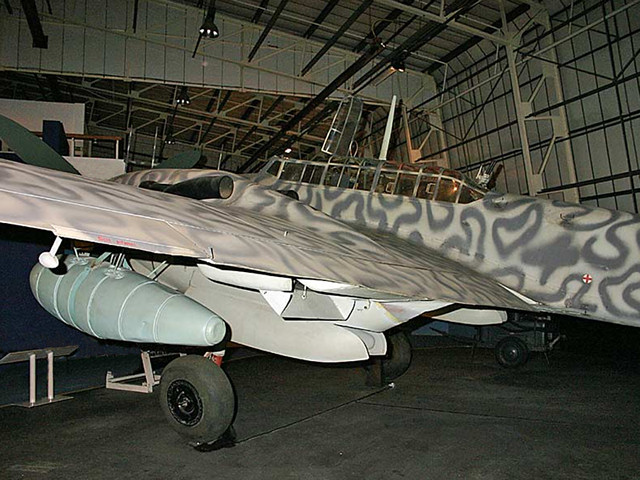|
In mid 1940 being sent on missions as a day-fighter over the English Channel, Kent, Sussex, Surrey and London during the Battle of Britain, the Messerschmitt BF110 losses increased. The Bf 110 couldn’t match the performance of the fast single engine RAF fighters such as the Spitfire or Hurricane. The Bf 110's lack of agility in the air was its primary weakness.
Despite suffering very serious losses during the Battle of Britain the aircraft continued in production. In 1940 the Messerschmitt factories turned out 1,008 Messerschmitt Bf 110 fighters and 75 Messerschmitt Bf 110 reconnaissance aircraft. During the Balkans Campaign, North African Campaign and on the Eastern Front, it rendered valuable ground support to the German Army as a potent fighter-bomber (Jagdbomber-Jabo).
The Messerschmitt Bf 110 C was also produced in fighter-bomber (C4, C7) and reconnaissance (C5) sub-variants.
The Messerschmitt Bf 110 D variant was originally intended as a long-range escort fighter, and the Bf 110 D0 pre-series aircraft featured a large ventral fuel tank, but the drag this created impaired the aircraft's performance to the extent that it was deleted in the production Bf 110 D1 and replaced by external wing tanks.
The Messerschmitt Bf 110 D2 variant could be used in either the fighter or bomber roles and could carry up to two 1000 kg (2205 1b) bombs, and the Bf110 D3 variant was a D1 with bomb racks attached.
The Messerschmitt Bf -110 E1 and E2 were designed as fighter-bombers and were able to carry four 50 kg (110 1b) bombs under the wing in addition to the larger bombs slung under the fuselage, while the E3 was a special long-range reconnaissance model.
The Messerschmitt Bf 110 F was similar to the E but with a strengthened airframe and upgraded armour. Designed either as a fighter-bomber (F1), a long-range fighter (F2) or a long-range reconnaissance (F3), it was the F4 that was specifically designed as a 3-crew night-fighter.
Earlier variants had 1300 hp DB 601 engines, but the final major production aircraft, the Messerschmitt Bf 110 G, produced in larger numbers than any other variant, adopted the 1350 hp DB 605 engine. Produced for all roles, but it was in the night-fighter role of the G2 but mainly the G4 that the Me 110 truly excelled and was responsible for the majority of Bomber Command's night losses due to fighter attack from early 1943. The top German night fighter ace, Major Heinz-Wolfgang Schnaufer, flew the Messerschmitt Bf 110 exclusively and claimed 121 victories in 164 combat missions.
Fitted with additional fuel tanks for a longer endurance, many of the Messerschmitt Bf 110 G night-fighters were fitted with the “Schraege Musik”, special machine guns firing at an angle of about 45° to a point above the fighter. This helped the crew to shoot down a bomber when flying parallel to it but underneath it.
A flame extinguisher, “Flammenvernichter” was also fitted instead of the normal exhaust system to help to subdue the blue exhaust flames so as to make it harder for enemy rear gunners to find their target.
The photograph is of Messerschmitt Bf 110 G4 production serial number 730301. It was constructed in 1944. By the beginning of 1945 it was stationed at fighter base in Denmark, with the “Stammkennzeichen” I/NJG 3. Its roll was night defence of Denmark and Northern Germany against Allied bomber attacks. It was fitted with FuG 220b Lichtenstein SN-2 radar to help it find the RAF bombers in the night skies.
In May 1945 at the end of the war the crew of Messerschmitt Bf 110 G4 730301 surrendered to the allies at Grove airfield and due to its radar equipment 730301 was transferred to the Royal Aircraft Establishment at Farnborough on the 3rd August 1945 for flight testing. It was saved from being scrapped and spent the post war years stored at various locations until in 7th August 1978 when after a short restoration at St.Athan in 1976 730301 was move by road and placed on display at RAF Hendon. This is the only intact aircraft of this type remaining anywhere in the world.
really wish to see a JMesserschmitt Bf 110 flying again at an airshow. New ME262s have been built and are flying. A next great project for someone with the money, time and the necessary skills would be to build and fly a Messerschmitt Bf 110 to make history come back to life.
These aircraft photographs are great reference sources if your painting 1/72 scale, 1/48 scale or 1/24 scale plastic model airplane Airfix, Tamiya, zvezda, revel, Pavala aircraft kits or you’re into flying and painting radio RC controlled model planes.
There are many aviation books published about the Messerschmitt Bf 110
www.MooreAircraft.com
Tell your friends about us. Send them an e-mail
|
